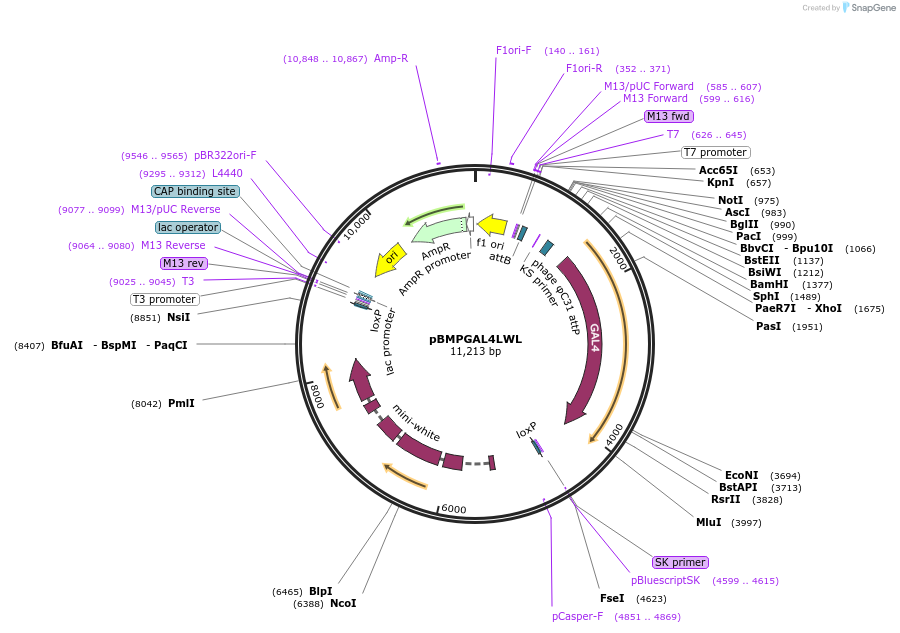pBMPGAL4LWL
(Plasmid
#26270)
-
Depositing Lab
-
Sequence Information
Ordering
| Item | Catalog # | Description | Quantity | Price (USD) | |
|---|---|---|---|---|---|
| Plasmid | 26270 | Standard format: Plasmid sent in bacteria as agar stab | 1 | $89 | |
Backbone
-
Vector backbonepBluescript II KS(-)
- Backbone size w/o insert (bp) 8248
-
Vector typeBacterial Expression, Insect Expression ; Drosophila transgenesis
Growth in Bacteria
-
Bacterial Resistance(s)Ampicillin, 100 μg/mL
-
Growth Temperature37°C
-
Growth Strain(s)DH5alpha
-
Copy numberHigh Copy
Gene/Insert
-
Gene/Insert nameGAL4
-
SpeciesS. cerevisiae (budding yeast)
-
Insert Size (bp)2965
-
Entrez GeneGAL4 (a.k.a. YPL248C, GAL81)
Cloning Information
- Cloning method Restriction Enzyme
- 5′ cloning site BamHI (not destroyed)
- 3′ cloning site HindIII (not destroyed)
- 5′ sequencing primer M13F
- (Common Sequencing Primers)
Resource Information
-
A portion of this plasmid was derived from a plasmid made bypGaTB (obtained from Drosophila Genomics Resource Center)
-
Article Citing this Plasmid
Terms and Licenses
-
Academic/Nonprofit Terms
-
Industry Terms
- Not Available to Industry
Trademarks:
- Zeocin® is an InvivoGen trademark.
Depositor Comments
Brand and Perrimon. Development. 1993 Jun;118(2):401-15.
These plasmids were created by your colleagues. Please acknowledge the Principal Investigator, cite the article in which the plasmids were described, and include Addgene in the Materials and Methods of your future publications.
-
For your Materials & Methods section:
pBMPGAL4LWL was a gift from Tom Clandinin (Addgene plasmid # 26270 ; http://n2t.net/addgene:26270 ; RRID:Addgene_26270) -
For your References section:
A versatile in vivo system for directed dissection of gene expression patterns. Gohl DM, Silies MA, Gao XJ, Bhalerao S, Luongo FJ, Lin CC, Potter CJ, Clandinin TR. Nat Methods. 2011 Mar;8(3):231-7. doi: 10.1038/nmeth.1561. 10.1038/nmeth.1561 PubMed 21473015







